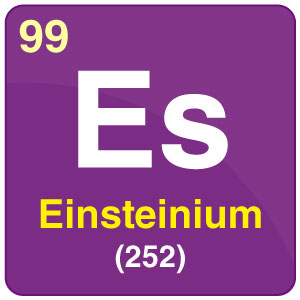
| Symbol | Es |
| Atomic Number | 99 |
| Atomic Mass | 252 |
| Discovered by | Einsteinium was discovered as a component of the debris of the first hydrogen bomb explosion in 1952. |

Einsteinium belongs to group 13 of the heavy transuranic subseries of elements found in the actinide series. It was discovered after World War II sometime in 1952 as a trace element in the residue from the massive explosion of the hydrogen bomb on Eniwetok.
Einsteinium does not exist in nature and is not found in the Earth’s crust. It is produced in small amounts by artificial natural transmutations of other radioactive elements rather than by an additional explosion of thermonuclear weapons.
Table of Contents
- What is Einsteinium?
- Discovery of Einsteinium
- Isotopes of Einsteinium
- Properties of Einsteinium
- Uses of Einsteinium
What is Einsteinium?
- Einsteinium is a synthetic element and a part of the periodic table with atomic number 99.
- Einsteinium, which is transuranium, was discovered during the analysis of nuclear products recovered from debris following a thermonuclear explosion (Weapon test device, “Mike”, November 1952) in the Pacific Ocean. Through initial investigations, fermium and other elements were discovered.
- The second element was named in honour of Albert Einstein, and given the name Einsteinium. It is, it is produced through a chain of nuclear reactions that involves bombarding each isotope and then allowing isotope beta decay.
Discovery of Einsteinium
- The discovery of einsteinium (element 99) was an unexpected result of the detonation of the first thermonuclear device, “Mike”, which took place on November 1, 1952.
- Einsteinium, the seventh transuranic element of the actinide series to be discovered, was identified by Ghiorso and co-workers at Berkeley in December 1952 in debris from the first large thermonuclear explosion, which took place in the Pacific.
- The discoveries of many of the transuranium elements were the result of careful preliminary planning, taking into account experimental techniques and predictions of chemical and nuclear properties.
- Einsteinium was one of these trace elements that was detected. Its existence, as well as several other discovered elements, was not announced until 1955, due to secrecy related to this new type of thermonuclear bomb.
Isotopes of Einsteinium
Einsteinium is a radioactive metallic element and a member of the actinide group of the periodic table. It reacts with the oxygen atom, steam, and acids but not with alkalies. Its preferred oxidation state is +3.
There are 17 known isotopes of einsteinium with mass numbers from 241 to 257 and three known isomers. All Einsteinium is radioactive and the longest-lived isotope is einsteinium-252 with a half-life of 472 days.
The symbol originally proposed for Einsteinium was just E, but when IUPAC approved the name in 1957 they changed the symbol to Es to conform with their new rule that said all newly named elements should have symbols with two letters.
Properties of Einsteinium
| Group | Actinides | Melting point | 860°C, 1580°F, 1133 K |
| Period | 7 | Boiling point | Unknown |
| Block | f | Density (g cm−3) | Unknown |
| Atomic number | 99 | Relative atomic mass | [252] |
| State at 20°C | Solid | Key isotopes | 252Es |
| Electron configuration | [Rn] 5f117s2 | CAS number | 7429-92-7 |
| ChemSpider ID | 22356 | ChemSpider is a free chemical database | |
Uses of Einsteinium
- Only tiny amounts of einsteinium have ever been produced; it is mainly used in scientific studies.
- Radioactive decay can be discovered through Einsteinium.
- It is among the heaviest elements on which bulk studies can be performed.
- It has a few medical uses but they are not commercial.
- It is used majorly to study radiation damage, targeted radiation medical treatments and accelerated ageing.
Learn more about the element in the periodic table from the expert faculties at BYJU’S.


This was very helpful